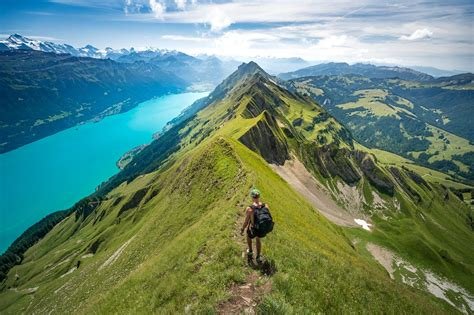Explore the best hiking trails and prepare for high altitude with our guide on essential gear, safety, and discovering the Alps’ hidden gems.Nestled in the heart of Europe, the majestic Swiss Alps beckon to adventurers with their towering peaks and breathtaking vistas. Whether you’re a seasoned hiker or just starting out on the path to becoming one with the mountains, our blog post, ‘An Adventurer’s Guide to Hiking in the Swiss Alps’, is the perfect compass to guide you through an unforgettable alpine journey. Venturing into this rugged landscape requires preparation, knowledge, and respect for nature’s grandeur. From choosing the right hiking trail tailored to your experience level, to preparing for the unique challenges of high altitude, we’ve got you covered. We will delve into the essential gear that makes the journey safer and more enjoyable, tips to navigate the mountain terrain confidently, and the best ways to appreciate the rich flora and fauna that make the Swiss Alps a hiker’s paradise. Additionally, we’ll reveal the secrets to uncovering those hidden alpine lakes that shimmer like jewels amidst the mountains. Lace up your boots, adventurers, as we embark on a quest to conquer the Swiss alpine trails, one step at a time.
Choosing the Right Hiking Trail
Embarking on a hiking journey through nature’s spectacular terrains requires the careful selection of a trail that aligns with your physical abilities, expectations, and personal preferences. When considering the right hiking trail, one must assess the trail’s difficulty level, often marked as easy, moderate, or challenging, to ensure it coincides with your experience and fitness level. Overestimating your capabilities may lead to a strenuous experience, while underestimating them may result in a lack of fulfillment. Hence, it is paramount to choose a trail that strikes the perfect balance between adventure and safety.
Another vital aspect when choosing the right hiking trail is to investigate the length and estimated duration of the hike. If the expedition requires multiple days, ascertain that you are prepared for overnight stays, be it in a tent, a cabin, or a designated shelter. Understanding the time commitment will also allow for proper planning with respect to daylight hours, as beginning a lengthy hike too late in the day can lead to the hazardous situation of navigating in the dark.
Apart from the physical considerations, the scenic offerings and unique landmarks of a hiking trail can greatly enhance the experience. Opting for trails that feature stunning views, waterfalls, historic sites, or peculiar formations often adds an enriching layer to your excursion. When you find yourself reflecting on why you chose to embark on this journey, remember that the allure of enchanting flora and fauna or the anticipatory excitement of discovering hidden alpine lakes can be powerful motivators in selecting the ideal path.
Lastly, always incorporate up-to-date research about the trail’s current conditions and any advisories that may impact your decision. Seasonal weather patterns, trail maintenance activities, or wildlife movements might influence trail accessibility and safety. Thus, engaging with local hiking communities or checking official park websites can be highly beneficial. By being thorough in your approach to choosing the right hiking trail, you ensure a rewarding and memorable hiking adventure that resonates with your personal pursuit of outdoor exploration.
Preparing for the High Altitude
Embarking on a high-altitude adventure can be both exhilarating and demanding, with each step upwards bringing new challenges and rewards. It is essential to consider the thinning air and its impact on your body; thus, acclimatizing to high altitude should be a top priority in your preparation. Carefully plan incremental increases in elevation during your journey, as this steady pace allows your body to adapt to the lower oxygen levels and reduces the risk of altitude sickness. Additionally, engaging in pre-trip fitness regimens that focus on cardiovascular conditioning can vastly improve your high-altitude experience.
Understanding the signs of altitude sickness is paramount in ensuring a successful trip. Watch for symptoms such as headaches, nausea, and dizziness—an indication that your body is struggling to adapt. Implementing precautionary measures such as maintaining proper hydration, a high-calorie diet, and adequate rest periods can be tremendously beneficial. Moreover, consider consulting with a healthcare professional before your trek who may recommend altitude sickness medication as a preventative step.
Packing appropriate gear is also critical when venturing into higher elevations. Protecting oneself from the harsh elements with layered clothing made from moisture-wicking and insulating materials will help regulate body temperature in the fluctuating climate. Furthermore, sunglasses with UV protection, sunscreen, and a high-quality, insulating hat are indispensable in your arsenal against the sun and cold. Remember, as you place one foot in front of the other, the right gear will help ensure your journey isn’t just about reaching the summit, but enjoying the climb.
Lastly, high altitude is not only about endurance; it is about the journey. Prioritize your safety, but also take the time to absorb the splendor of your surroundings. The unique perspective from such elevations can bring moments of profound introspection and joy. Reflect on why you sought out this high-altitude adventure, and how, in the thin air where the horizon seems just a little closer, you are reminded of the majesty and power of nature, intertwined with the depth of human ambition.
Essential Gear for Alpine Hiking
When embarking on an Alpine hiking adventure, the importance of being equipped with the right gear cannot be overstated. The unpredictable mountain conditions demand that hikers prepare adequately to ensure safety, comfort, and the ability to respond to emergencies. One of the most critical items on your checklist should be a pair of sturdy, supportive hiking boots designed for mountain terrain. These boots should offer substantial ankle support, grip, and be well broken-in to minimize the risk of blisters on rugged trails.
Packing the correct clothing is also a vital aspect of pre-trip preparation. Layering is key in alpine environments where temperatures can fluctuate drastically within hours. A base layer with moisture-wicking properties, an insulating mid-layer like a fleece or down jacket, and an outer layer that is both windproof and waterproof will help you maintain an optimal body temperature. Don’t forget thermal hats, gloves, and a neck gaiter for added protection against the cold.
Furthermore, your backpack should always include a first-aid kit, a high-quality topographic map, and a reliable compass or GPS device – these are indispensable for safe navigation in the Alpine region. The first-aid kit must be tailored to your group’s specific needs, including medication for altitude sickness if necessary. Additionally, consider carrying a multi-tool or a pocket knife, which can prove to be incredibly useful in various situations you might encounter on the trail.
Lastly, remember to bring a lightweight but robust tent, a sleeping bag appropriate for the season, and a sleeping pad for those overnight excursions. Adequate hydration is another concern – carrying a water filtration system or purification tablets ensures access to safe drinking water. And of course, high-energy snacks are a must for maintaining stamina during those long ascents. By packing the essential gear for your hike in the Alps, you are taking the first step towards a memorable and gratifying experience amidst nature’s grandeur.
Navigating the Swiss Alps Safely
Embarking on a journey through the majestic Swiss Alps requires careful planning and respect for the mountain environment to ensure a safe and enjoyable experience. Navigating the Swiss Alps safely means paying close attention to weather patterns, which can change rapidly and without warning. Utilizing reliable weather forecasting services, and adjusting your route accordingly, is critical for avoiding hazards such as sudden storms or avalanches. Additionally, it is essential to have a clear understanding of the trail difficulty levels and to stick to routes that align with your experience and fitness levels.
Map-reading skills and the use of a compass or GPS device are indispensable when traveling in the alpine region, where trails may be less distinguished and visibility can be compromised. Always carry a detailed topographical map of the area and know how to use it in conjunction with the navigation tools. Understanding how to navigate the terrain by identifying landmarks and contour lines can be a lifesaver if technical devices fail or your planned path becomes obscured. Besides technological aids, enrolling in a navigation course before your trip can immensely boost your confidence and orienteering abilities in the wilderness.
Safety protocols and preparedness are paramount when venturing into the Alps. This includes familiarizing yourself with local emergency procedures and understanding how to signal for help if you find yourself in distress. A Swiss Alpine Club (SAC) hut can offer a shelter but should not be relied upon without prior bookings or knowledge of their seasonal availability. Also, always inform someone of your planned route and estimated time of return, so that in the event you fail to check-in, rescuers have a starting point to search.
Lastly, the delicate environment of the Alps demands that hikers practice environmentally responsible hiking to preserve the area for future generations. Stay on marked trails to minimize erosion and disturbance to wildlife. Carrying out all litter, using established campfire rings, and treating water from streams are all practices that contribute to keeping the Alpine habitat pristine. Remember, the majestic scenery of the Swiss Alps is a privilege to enjoy, and with meticulous preparation and a strong commitment to safety, hikers can navigate this splendid landscape with rewarding and unforgettable experiences.
Enjoying the Flora and Fauna
Experiencing the richness of biodiversity while trekking through nature’s beauty is a remarkable experience to cherish. As you embark on your journey in the wild, allow yourself to absorb the splendor that the environment has to offer by enjoying the flora and fauna. Take notice of the many hues of green as you pass by a myriad of plant species, each playing its own unique role in the ecosystem. It is a great opportunity to familiarize yourself with rare flowers, ancient trees, and the natural heritage of the area; doing so enriches your hike with a deeper appreciation for the land’s vibrant life.
To fully bask in the glory of nature’s creations, it is essential to carry a guidebook or a digital resource that can help you identify different species of plants and animals. This practice can transform your hike from a mere walk into a fascinating educational adventure. If you have the chance, plan your hike around the blooming seasons to witness the magnificent display of colors when wildflowers are in their full splendor. Pay attention to the movements and the sounds as well, for these are the telltale signs that reveal the presence of the diverse wildlife inhabiting the area.
Photography enthusiasts will find no shortage of moments to capture, with the dynamic wildlife presenting endless opportunities for the perfect shot. Yet, while taking photographs, it is paramount to maintain a respectful distance from the wildlife and to abide by the principles of Leave No Trace to minimize the human impact on their natural habitats. The serenity of the alpine environment and the sight of animals in their home terrain is a privilege that comes with responsibility.
Finally, immerse yourself in the symphony of nature’s soundtrack. From the rustling leaves and the crunching of twigs beneath your feet to the murmur of a nearby stream and the calls of the highland birds, these are the echoes that remind us of the interconnected world we share with all living things. By treasuring the flora and fauna, we not only enhance our hiking experience but also foster a profound respect for the environment that sustains all forms of life.
Discovering Hidden Alpine Lakes
Embarking on a journey to discover hidden Alpine lakes can be an enriching experience that blends the thrill of exploration with the serene beauty of untouched nature. Nestled amidst the towering peaks, these lakes are often the jewels of the high mountains, offering a breathtaking vista for those persistent enough to seek them out. The paths leading there might range from well-trodden to scarcely discernible, encouraging a spirit of adventure in every hiker’s heart.
When setting out on such an expedition, it’s prudent to conduct thorough research on the location and accessibility of Alpine lakes. Many of these are not marked on standard maps and might require guidance from local experts or detailed topographical charts. Indeed, the complexity of the terrain necessitates a certain level of physical preparedness and a keen awareness of one’s surroundings, as the elements in high-altitude environments can be both unpredictable and unforgiving.
Moreover, the journey to hidden Alpine lakes is often laden with surprises, from unexpected wildlife encounters to dramatic shifts in weather. Thus, ensuring that one has the appropriate gear and provisions is paramount. Navigational tools like compasses and GPS devices can serve as invaluable assets, especially when traversing less defined paths where the risk of straying off-course is increased. Nonetheless, the reward of arriving at a secluded glacial lake, its waters reflecting the sublime beauty of the Alps, is undoubtedly worth every step.
To truly appreciate these sanctuaries, it’s essential to approach them with a sense of reverence and responsibility. Many hidden lakes are situated in delicate ecosystems, and their preservation relies heavily on the principles of Leave No Trace. By minimizing our impact and ensuring we leave these natural wonders as pristine as we found them, we play a part in safeguarding them for future generations of intrepid explorers and nature enthusiasts.
Frequently Asked Questions
How do I pick the most suitable hiking trail in the Swiss Alps?
Choosing the right hiking trail in the Swiss Alps depends on your physical fitness, hiking experience, and the level of challenge you’re seeking. Research trails ahead of time, consider the elevation gain and distance, and check recent trail reports for current conditions. Start with easier routes if you’re a beginner and gradually work up to the more demanding ones.
What should I do to prepare for hiking at high altitudes?
To prepare for high altitudes, you should acclimatize by spending a few days at moderate elevation before ascending higher. Stay hydrated, eat a diet rich in carbohydrates, and avoid overexertion. Also, learn to recognize the symptoms of altitude sickness and know how to respond to them.
Can you list some essential gear items for alpine hiking?
Essential gear for alpine hiking includes a sturdy pair of hiking boots, layered clothing to accommodate changing weather, a weatherproof jacket, a backpack with a hydration system, sunscreen and sunglasses for protection against UV rays, a first-aid kit, navigation tools like a map and compass or a GPS device, and trekking poles for stability.
What are the best practices for staying safe while navigating the Swiss Alps?
To navigate the Swiss Alps safely, always plan your route and leave an itinerary with someone. Check the weather forecast before heading out, stay on marked trails, be prepared to turn back if conditions worsen, and carry a charged mobile phone with emergency numbers saved. Consider hiring a guide if you’re unfamiliar with the terrain.
How can hikers fully enjoy the flora and fauna in the Alps without disturbing the ecosystem?
To enjoy the flora and fauna while minimizing impact, stay on designated trails to avoid trampling plants. Observe wildlife from a distance without feeding or approaching them. Follow the Leave No Trace principles: take only pictures, leave only footprints, and be mindful of your noise levels to avoid disturbing animals.
Are there any tips for discovering hidden alpine lakes while hiking?
Discovering hidden alpine lakes often entails venturing off the more popular trails. Research lesser-known routes or ask local guides for insider tips. Use a detailed topographic map to identify potential lakes and plan a route accordingly. Be prepared for rougher terrain and ensure you have the experience and gear to traverse it safely.
What’s the best time of year to go hiking in the Swiss Alps to experience the natural beauty?
The best time of year to go hiking in the Swiss Alps to experience the natural beauty is during the summer months, from June to September, when the weather is most stable, and the trails are clear of snow. This period offers the best chance to see wildflowers in bloom, wildlife, and enjoy the alpine scenery with comfortable temperatures.


